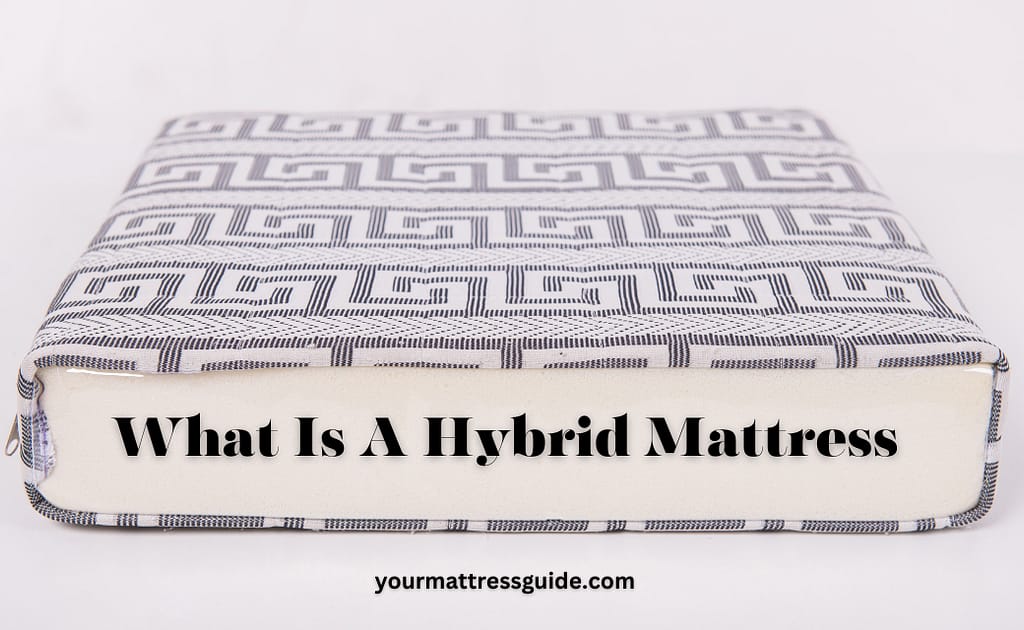To accommodate various body types and sleeping positions, a hybrid mattress combines the advantages of many layers of foam with classic spring coils. Even though a hybrid mattress might not be the ideal option for everyone, it might be an excellent starting point for buyers who aren’t sure what they want.
Although hybrid mattresses are becoming increasingly popular, some manufacturers use the phrase more for marketing purposes than for the actual type of mattress.
We’ll look at hybrid mattresses’ design, components, and functionality and the kinds of sleepers who benefit from them. We’ll also examine the price, durability, benefits and drawbacks of hybrid mattresses before you can choose the one that best suits your requirements.

What Is A Hybrid Mattress Material?
An innerspring stability core is sandwiched between layers of foam comfort system in a hybrid mattress. Memory foam, latex, polyfoam, micro coils, or an array of these materials can be used to create its comfort layer.
The kind, thickness, and quantity of metal coils that make up an innerspring support core varies, which impacts the spring’s overall feel and functionality.
These are frequently pocketed coils in hybrid mattresses, enhancing motion isolation. Different-sized coils are frequently used in the assistance core of hybrid mattresses to provide zonal support and a more substantial perimeter.
Certain manufacturers refer to their all-foam beds that combine memory foam and latex layers as hybrid beds. But since these beds don’t have an innerspring core, they aren’t hybrids.
Types Of Hybrid Mattress
A hybrid’s construction and material choices affect how well it performs. For instance, any of the following could be present in the comfort layer:
- Memory foam relieves pressure in delicate parts of the body by conforming to it.
- Compared to memory foam, Polyfoam offers a firmer sleeping surface and conforms to the sleeper to a moderate extent.
- Latex: Latex conforms to the body while providing sleepers a more responsive sensation.
- Microcoils: Underneath the top comfort layer, microcoils are small metal coils that provide support and ventilation.

A hybrid mattress’s support core typically comprises pocketed, also known as Marshall coils. These are discrete fabric-wrapped coils that move apart from one another.
Because pocketed coils react to changes in weight without moving other coils, sleepers are less likely to wake up their companion when they move or get in or out of bed.
Other less typical coil kinds that buyers of hybrid beds can encounter are:
- Bonnell coils: These are linked, hourglass-shaped coils that move together as a single unit.
- Offset coils: Enhanced motion isolation is achieved by modifying offset coils, which bear similarities to Bonnell coils.
- Continuous coils: These are rows of coils made of a single wire that provide strong support while facilitating more motion transfer.
Hybrid Mattresses vs. Foam Mattresses
Coils are not used in the manufacturing of foam mattresses. Both natural and artificial foams fall under the “foam” category, and some beds may combine the two.
Despite being created by NASA at first, various memory foam forms have now gained popularity for pillows, cushions, and mattresses because they conform to your body when heat softens the foam.
Because of this, memory foam helps minimize bounciness and support your spine evenly while you sleep. However, it can also retain heat, which is unsuitable for hot sleepers.
For people who don’t want to sink on a mattress or have an interest in eco-friendly options, other forms of foam mattresses, such as latex, may be an excellent choice because they don’t conform to the body.
In addition to standard innerspring, memory foam layers are a typical component of hybrid mattresses. This allows sleepers to benefit from the soft sensation of memory foam combined with the support of a thick layer of coils.
Hybrid Mattresses vs.Innerspring Mattresses
Generally, a foam layer is absent from a traditional spring mattress. Instead, most of the mattress is made up of a traditional arrangement of metal springs covered and surrounded by a few thin layers of foam or cushioning.
Traditional spring mattresses seem bouncy because of the metal springs inside, mainly if you sleep alongside a partner or a moving pet.
By providing layers of foam that will lessen motion transmission while maintaining the support of innerspring, hybrids solve the issue of bounciness.
How Much Does A Hybrid Mattress Cost?
Although some hybrid beds are more expensive than this range, a queen-size hybrid mattress typically costs between $1,200 and $3,000. The price of the hybrid is typically lower than that of foam and innerspring variants, more in line with the cost of latex beds.
However, due to the materials and design used in its manufacture, the price of a hybrid mattress differs more than that of other types of beds.
Price-determining factors include the size and quantity of coils, the type of foam utilized, and the thickness of the comfort layer. The manufacturing site, natural or organic materials, and specialized cooling technologies are all essential considerations.
How Long Does a Hybrid Mattress Last?
The majority of hybrid mattresses last between six and eight years on average. When properly maintained, hybrids made of high-quality materials usually have longer lifespans.
Firmer foam and a thicker comfort system might make a model last longer than one with a thin, soft comfort layer. Hybrid mattresses also typically last as long as foam beds and innerspring mattresses.
Over time, a mattress’s performance may be impacted by its use. A couple’s combined weight is more strain on the bed’s construction than a single sleeper’s. A mattress can be protected from harm by being covered with a mattress covering or encasement.
How To Choose A Hybrid Mattress?
Selecting a mattress is a subjective choice that must consider each person’s requirements and preferences. But to make an informed choice, you should consider things like body type, sleeping posture, and price range. We examine these variables in more detail to help you choose which hybrid mattress is best for you.
Sleeping Position:
The position you sleep in most of the night is known as your primary sleep position. Different degrees of support are needed for each type of sleeper to preserve spinal alignment and relieve pressure points. The most significant kind of mattress for each sleeper depends on their body type and personal preferences.
Side sleepers:
Side sleepers typically require a deeper comfort layer with mild contouring to cushion their hips and shoulders. A firmer mattress won’t ease pressure spots sufficiently. The pushback and responsiveness of a coil support core, which aids in maintaining the spine’s alignment, are also advantageous to side sleepers.
Back sleepers:
Back sleepers require a mattress that supports their lower back without allowing their hips and shoulders to sink too much to preserve neutral spine alignment. An excessively supple memory foam comfort layer might not offer the necessary support for back sleepers. The lumbar area may benefit from additional support from a hybrid with zoned coils.
Stomach Sleepers:
the memory foam comfort layers may be too soft and need a more rigid surface. Comfort layers of latex and polyfoam provide superior support for stomach sleepers by aiding the spine’s alignment.
What Is A Hybrid Mattress For Body Type:
Each hybrid mattress may feel and function differently depending on the sleeper’s body type and size category. A different body type may find discomfort in what is comfortable for one sleeper. Three categories are used to describe body type:
- Individuals weighing less than 130 pounds: These sleepers frequently require a softer comfort layer for the best pressure relief.
- Individuals weighing between 130 and 230 pounds: These sleepers frequently like a mix of support and shaping.
- Over 230 pounds: Those in this weight range typically need more support from a firm sleep surface and a coil support core since they sink deeper into the mattress.
Body Pain:
The harmony of support and contouring in a hybrid mattress may help people with physical pain feel less uncomfortable.
With so many hybrid alternatives available, those with hip, back, or neck problems may find it easier to locate a bed that meets their specific needs due to the variety of materials and firmness levels.
For instance, the pocketed coils in many hybrid mattresses are made to support every body part as it reacts to pressure differently. More support is provided to specific body parts by zoned support cores, which can also aid in pain relief.
Firmness:
A 10-point firmness scale, with 1 being incredibly soft and 10 being extremely firm, is used to rate the hardness of mattresses. The degree to which the mattress feels firm and how much you sink into it depends on your body type and sleeping position.
For instance, a stomach roller over 230 pounds may discover that a medium-firm model allows too much sinkage. In comparison, a side sleeper beneath 130 pounds may find that a medium mattress doesn’t sufficiently cushion pressure points.
Budget:
When deciding on a new mattress budget, it’s crucial to consider your sleep needs because a mattress is expensive. Although hybrid mattresses are more expensive than other mattresses, some versions fit every budget. A lot of manufacturers also cater to value customers with specials and discounts.

Pros & Cons Of Using Hybrid Mattress
If you like foam’s conformance but prefer the comfort and firmness of an innerspring type, consider looking into a hybrid mattress.
Because of its edge support and movement mobility, hybrid beds are frequently preferred by couples and active sleepers.
Those who overheat in all-foam mattresses may appreciate the enhanced ventilation of a hybrid bed’s coil support core.
Hot sleepers should know that a hybrid memory foam mattress could still be overly warm. A latex hybrid, on the other hand, provides greater temperature regulation and retains less body heat.
Like hybrid mattresses, this kind of mattress is more costly, so buyers might need to look around to locate one that fits within their budget.
Let’s take a quick look at their pros and cons
| PROS | CONS |
| Combine the reactivity and support of the innerspring with the foam’s pressure-relieving and contouring qualities. | Typically more costly than beds with innerspring or all-foam |
| They fit many different sleep styles because they come in various substances and firmness levels. | Memory foam models could still be too warm for those who get hot easily. |
| accessible at a variety of pricing points to suit any budget |
Does a Hybrid Mattress Need a Box Spring?
Box springs were formerly an essential companion to any mattress, but current hybrid mattresses often do not need the support of a standard box spring.
A hybrid mattress can be supported adequately with a slatted foundation, but it’s a good idea to check with the manufacturer to find out if there are any particular guidelines.
For example, Avocado specifies that the slats must be at least 2.5 inches broad and no more than 5 inches apart. A bunkie board, which is a flat piece of plywood or particle board, is what some firms advise placing under a hybrid mattress.
Is It Worth It?
Although hybrid mattresses are more expensive than standard spring or foam-only mattresses, they are still an excellent option for many different sleepers. However, the high cost of hybrid mattresses frequently indicates that you are getting luxury materials or additional functions.
But not every hybrid needs to be extremely expensive. You can get a fantastic deal and a long-term investment with the proper budget and pricing.
Wrapping It Up!
Well, that’s it from our side, folks! Here you have a complete guide on a Hybrid Mattress with its pros and cons, types, and learning how to choose the best one for yourself.
If this was helpful, take a moment to look at our types of mattress blog, where we discuss every mattress type in detail. We can guarantee it will be fruitful in the long run. For more information about types of mattress and their pros and cons check out the article on what are the types of mattresses.
FAQs
Are hybrid mattresses firm or soft?
A hybrid mattress is a medium-firm product that falls between a firm memory foam mattress and a conventional mattress that feels like a cloud. This is because it combines both firm and soft layers. A hybrid mattress’s many materials provide a number of advantages, including pressure alleviation, support, comfort, and bounce.
Do hybrid mattresses get hot?
While many hybrid mattresses are available, most have similar advantages. Enhanced Temperature Regulation: Hybrid mattresses sleep colder than all-foam ones because of the coil support structure. Because air passes through the core, overheating may be avoided.
Who needs a hybrid mattress?
If you like the conformance of foam but would prefer the bounce and stability of an innerspring type, you might want to look into a hybrid mattress. Because of its edge support and mobility of movement, hybrid beds are frequently preferred by couples and active sleepers.


